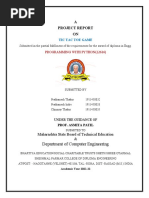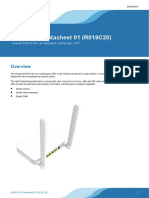Notes Advance Java
Uploaded by
vrunani muleyNotes Advance Java
Uploaded by
vrunani muleyUNIT-IV Networking Basics… KM…
*************Networking Basics*************
Java NetWorking:-
Java Networking is a concept of connecting two or more computing
devices together so that we can share resources.
Java socket programming provides facility to share data between
different computing devices.
Advantages of Java Networking:-
1)Share Resources.
2)Centralize software Management.
NetWorking Terms:-
1)IP Address:-
IP Address is a unique number assigned to a node of a network eg.
192.168.0.1,It is composed of octets that range from 0 to 255.
2)Protocol:-
A Protocol is a set of rules basically this is Followed for Communication
For Example:-
I)TCP
II)FTP
III)Telnet
IV)SMTP
V)POP ext.
3)Port Number:-
The Port Number is used to uniquely Identify different application.
It acts as a Communication endpoint between application.
The port number is associated with the IP address for Communication
between two Applications.
port is a number socket on a Particular machine.
Advance Java by Mr.Vishal Jadhav sir’s(VJTech Academy,contact us:+91-9730087674).
UNIT-IV Networking Basics… KM…
4)Connection-oriented and connection-less Protocol:-
In Connection-oriented Protocol,acknowledgement is sent by the
receiver.so it is reliable but slow.The Example of Connection-oriented
Protocol is TCP.
But,In Connection-less Protocol,acknowledgement is not sent by the receiver.
so it is not reliable but fast.The Example of Connection-less Protocol is UDP.
5)Socket:-
A Socket is an endpoint betweentwo way Communication.
6)Proxy Servers
7)Client-Server
8)Reserved Socket
9)Internet Addressing
A-> 0 to 127 B-> 128 to 191 C-> 192 to 223 D-> 224 to 239 E-> 239 to 255.
10)Domain Naming Services.
#### InetAddress ####
- java.net package
- InetAddress stands for Internet Address
- InetAddress is a combination of IP address and Host Name.
- InetAddress is a predefined class which is present under java.net package.
***Factory Methods:-
1) static InetAddress getLocalHost()
2) static InetAddress getByName(String hot_name)
3) static InetAddress getAllByName(String hot_name)
4) static InetAddress getByAddress(String IP_Address)
Advance Java by Mr.Vishal Jadhav sir’s(VJTech Academy,contact us:+91-9730087674).
UNIT-IV Networking Basics… KM…
- All these three methods will throws UnKnownHostException
***Instance Methods:-
1) boolean equals(object obj)
2) byte[] getAddress()
3) String getHostAddress();
4) String getHostName();
5) String toString();
6) boolean isMulticastAddress()
Code:-
import java.net.*;
class InetAddressDemo
{
public static void main(String args[])throws UnknownHostException
{
InetAddress addr=InetAddress.getLocalHost();
System.out.println(addr);
addr=InetAddress.getByName("www.msbte.com");
System.out.println(addr);
System.out.println("(wwww.msbte.com)Is Multicast Addresss
Multicast Address="+addr.isMulticastAddress());
InetAddress a[]=InetAddress.getAllByName("www.google.com");
for(int i=0;i<a.length;i++)
{
System.out.println(a[i]);
}
}
}
URL:-
- URL stands for Uniform Resource Locator.
- Here, we need to handle the exception MalformedURLException.
- URL string consists of three part
1) Network protocol
Advance Java by Mr.Vishal Jadhav sir’s(VJTech Academy,contact us:+91-9730087674).
UNIT-IV Networking Basics… KM…
2) Host Name or IP address
3) File path or resource location
Syntax:-
Protocol://hostnameorIPaddress:portno/filepath
Example:-
http://www.vjtechacademy.com/about.html
***Constructor:-
1) URL(String urlstring)
2) URL(String protocolName, String HostName, int port, String filepath);
3) URL(String protocolName, String HostName,String filepath);
***Methods:-
1) String getProtocol();
2) int getPort();
3) String getHost();
4) String getFile();
Code:-
import java.net.*;
class URLDemo
{
public static void main(String args[])throws MalformedURLException
{
URL u1=new URL("https://www.vjtechacademy.com80/about.html");
System.out.println("Protoclol="+u1.getProtocol());
System.out.println("Host Name="+u1.getHost());
System.out.println("Port Name="+u1.getPort());
System.out.println("File path="+u1.getFile());
}
}
URLConnection:-
- It is used to access attributes of remote resources.
**Methods:-
1) int getContentLength()
2) String getContentType()
3) long getDate();
4) long getlastModified()
Advance Java by Mr.Vishal Jadhav sir’s(VJTech Academy,contact us:+91-9730087674).
UNIT-IV Networking Basics… KM…
5) long getExpiration()
6) InputStream getInputStream()
Code:-
import java.net.*;
import java.util.*;
class URLConnectionDemo
{
public static void main(String args[])throws Exception
{
URL u1=new URL("https://www.msbte.com");
URLConnection u2=u1.openConnection();
System.out.println("Date="+new Date(u2.getDate()));
System.out.println("Type of contents="+(u2.getContentType()));
System.out.println("length of contents="+(u2.getContentLength()));
System.out.println("Expiration Date="+new Date(u2.getExpiration()));
System.out.println("Last Modified Date="+new Date(u2.getLastModified()));
}
}
TCP/IP server (ServerSocket) and client (Socket):
- ServerSocket and Socket both are predefined classes which are present
under java.net package.
***Socket class:
Constructors:-
1) Socket(String HostName,int port)
2) Socket(InetAddress addr,int port)
Methods:-
1) InetAddress getInetAddress();
2) int getPort();
3) int getLocalPort();
4) InputStream getInputStream()
5) OutputStream getOutputStream()
6) void close()
***ServerSocket Class:-
Advance Java by Mr.Vishal Jadhav sir’s(VJTech Academy,contact us:+91-9730087674).
UNIT-IV Networking Basics… KM…
Constructors:-
1) ServerSocket(int port)
2) ServerSocket(int port , int maxqueue)
3) ServerSocket(int port,int maxqueue,InetAddress addr);
4) accept();
Diagram:-
Code:-
//CLIENT Program
import java.net.*;
import java.io.*;
class Client
{
public static void main(String args[])throws Exception
{
Socket s=new Socket("locolhost",8989);
InputStream in=s.getInputStream();
OutputStream out=s.getOutputStream();
Advance Java by Mr.Vishal Jadhav sir’s(VJTech Academy,contact us:+91-9730087674).
UNIT-IV Networking Basics… KM…
byte str[]="Hi Server".getBytes();
out.write(str);
s.close();
}
}
//SERVER Program
import java.net.*;
import java.io.*;
class Server
{
public static void main(String args[])throws Exception
{
ServerSocket ss=new ServerSocket(8989);
Socket s1=ss.accept();
InputStream in=s1.getInputStream();
OutputStream out=s1.getOutputStream();
int c;
while((c=in.read())!=-1)
{
System.out.print((char)c);
}
ss.close();
}
}
****************************************************************
Code 2:-
//Client-1 Program
import java.net.*;
import java.io.*;
class ClientDemo
{
public static void main(String args[])throws Exception
{
Socket s=new Socket("localhost",9090);
BufferedReader br=new BufferedReader(new InputStreamReader(System.in));
DataInputStream din=new DataInputStream(s.getInputStream());
DataOutputStream dout=new
DataOutputStream(s.getOutputStream());
String str1="";
while(!str1.equals("bye"))
Advance Java by Mr.Vishal Jadhav sir’s(VJTech Academy,contact us:+91-9730087674).
UNIT-IV Networking Basics… KM…
{
str1=br.readLine();
dout.writeUTF(str1);
str1=din.readUTF();
System.out.println("Server says:"+str1);
}
s.close();
}
}
//server-1 Program
import java.net.*;
import java.io.*;
class ServerDemo
{
public static void main(String args[])throws Exception
{
ServerSocket ss=new ServerSocket(9090);
Socket s=ss.accept();
BufferedReader br=new BufferedReader
(new InputStreamReader(System.in));
DataInputStream din=new DataInputStream(s.getInputStream());
DataOutputStream dout=new DataOutputStream
(s.getOutputStream());
String str1="";
while(!str1.equals("bye"))
{
str1=din.readUTF();
System.out.println("Client Says:"+str1);
str1=br.readLine();
dout.writeUTF(str1);
}
ss.close();
ss.close();
}
}
Advance Java by Mr.Vishal Jadhav sir’s(VJTech Academy,contact us:+91-9730087674).
UNIT-IV Networking Basics… KM…
Output:-
********************************************************
Datagrams:-
- Here, we use two predefined classes Datagrampacket & DatagramSocket.
***Constructors of Datagrampacket:-
1) Datagrampacket(byte data[],int size)
2) Datagrampacket(byte data[],int offset,int size)
3) Datagrampacket(byte data[],int size,InetAddress addr,int port)
4) Datagrampacket(byte data[],int offset, int size,InetAddress
addr,int port);
***methods of Datagrampacket:-
1) InetAddress getAddress();
2) int getPort();
3) byte[] getData();
4) int getLength();
5) int getOffset();
6) void setAddress(InetAddress addr)
7) void setData(byte data[]);
8) void setLength(int length)
Advance Java by Mr.Vishal Jadhav sir’s(VJTech Academy,contact us:+91-9730087674).
UNIT-IV Networking Basics… KM…
9) void setPort(int port)
***Constructors of DatagramSocket:-
1) DatagramSocket()
2) DatagramSocket(int port)
3) DatagramSocket(int port,InetAddress addr)
4) DatagramSocket(DatagramSocketImpl obj)
*** Methods of DatagramSocket:-
1) void send(Datagrampacket obj)
2) void receive(Datagrampacket obj)
3) int getLocalport();
4)int getPort();
5)void connect(InetAddress addr,int port);
6) void disconnect();
7) void close();
Code:-
//Sending DatagramPackets using DatagramSocket.
import java.net.*;
class DataSender
{
public static void main(String args[])throws Exception
{
DatagramSocket ds=new DatagramSocket();
String str="Welcome to world of Networking Programming
of Advance java!!!";
byte data[]=str.getBytes();
int len=str.length();
InetAddress addr=InetAddress.getByName("127.0.0.1");
DatagramPacket dp=new DatagramPacket(data,len,addr,5555);
ds.send(dp);
ds.close();
}
}
//Receiving DatagramPackets using DatagramSocket.
import java.net.*;
class Receiver
{
Advance Java by Mr.Vishal Jadhav sir’s(VJTech Academy,contact us:+91-9730087674).
UNIT-IV Networking Basics… KM…
public static void main(String args[])throws Exception
{
DatagramSocket ds=new DatagramSocket(5555);
byte data[]=new byte[1024];
DatagramPacket dp=new DatagramPacket(data,1024);
ds.receive(dp);
String str=new String(dp.getData(),0,dp.getLength());
System.out.println(str);
ds.close();
}
}
Output:-
Advance Java by Mr.Vishal Jadhav sir’s(VJTech Academy,contact us:+91-9730087674).
UNIT-IV Networking Basics… KM…
Inspiring Your Success
VJTech Academy…
Advance Java by Mr.Vishal Jadhav sir’s(VJTech Academy,contact us:+91-9730087674).
You might also like
- OOP - I GTU Study Material Presentations Unit-1 07022022102854PMNo ratings yetOOP - I GTU Study Material Presentations Unit-1 07022022102854PM59 pages
- Unit2: Answer: We Cannot Create Object For Anonymous ClassNo ratings yetUnit2: Answer: We Cannot Create Object For Anonymous Class2 pages
- Chapter 2 - Multithreading - PPTX (Autosaved)No ratings yetChapter 2 - Multithreading - PPTX (Autosaved)46 pages
- Practical Outcomes (Pros) :: Practical No 05: Strings in PHPNo ratings yetPractical Outcomes (Pros) :: Practical No 05: Strings in PHP6 pages
- Oops Concept in Java - Object Oriented Programming in Java0% (1)Oops Concept in Java - Object Oriented Programming in Java24 pages
- A Project Report ON: Department of Computer EngineeringNo ratings yetA Project Report ON: Department of Computer Engineering13 pages
- Industrial Training Report: Submitted byNo ratings yetIndustrial Training Report: Submitted by18 pages
- Unit No.2 Derived Syntactical Constructs in Java: There Are Two Types of ConstructorNo ratings yetUnit No.2 Derived Syntactical Constructs in Java: There Are Two Types of Constructor27 pages
- 30 Days Strategic Study Plan by Ur Engineering FriendNo ratings yet30 Days Strategic Study Plan by Ur Engineering Friend10 pages
- IT51 JAVA PROGRAMMING 2-MARK Questions and Answers UNIT-1No ratings yetIT51 JAVA PROGRAMMING 2-MARK Questions and Answers UNIT-116 pages
- Unit I Basic Syntactical Constructs in JavaNo ratings yetUnit I Basic Syntactical Constructs in Java21 pages
- Government Polytechnic, Jalna Computer Engineering DepartmentNo ratings yetGovernment Polytechnic, Jalna Computer Engineering Department16 pages
- Aim & Algorithm Program Results Viva-Voce Record Total 20 40 20 10 10 10050% (4)Aim & Algorithm Program Results Viva-Voce Record Total 20 40 20 10 10 1005 pages
- Software Testing Important Question Bank.No ratings yetSoftware Testing Important Question Bank.6 pages
- Service Description BT Ethernet ConnectNo ratings yetService Description BT Ethernet Connect18 pages
- ch22 Network Layer Routing Forwarding and DeliveryNo ratings yetch22 Network Layer Routing Forwarding and Delivery40 pages
- Communication Networks Fundamental Concepts and Key Architectures 2nd Edition Alberto Leon Garcia And Indra Widjaja 2024 Scribd Download100% (7)Communication Networks Fundamental Concepts and Key Architectures 2nd Edition Alberto Leon Garcia And Indra Widjaja 2024 Scribd Download71 pages
- 03 Getting Started With Sophos FirewallNo ratings yet03 Getting Started With Sophos Firewall226 pages
- Understand and Configure Nexus 9000 VPCNo ratings yetUnderstand and Configure Nexus 9000 VPC25 pages
- Manual Configuración Router HUAWEI EG8145V5No ratings yetManual Configuración Router HUAWEI EG8145V53 pages
- CN Module 1 Notes - Data Communications & NetworksNo ratings yetCN Module 1 Notes - Data Communications & Networks53 pages
- Be Electronics and Telecommunication Engineering Semester 5 2023 May Computer Networks Cn Pattern 2019No ratings yetBe Electronics and Telecommunication Engineering Semester 5 2023 May Computer Networks Cn Pattern 20192 pages
- Nokia - Comandos y Sus Salidas Por Pantalla100% (1)Nokia - Comandos y Sus Salidas Por Pantalla2 pages
- Top 25+ Most Asked BGP Interview Questions and Answers (2023) - JavatpointNo ratings yetTop 25+ Most Asked BGP Interview Questions and Answers (2023) - Javatpoint13 pages
- SRL Workshop - 7750interop - DCI - v0.1No ratings yetSRL Workshop - 7750interop - DCI - v0.130 pages
- Quectel BG770A-GLBG95xA-GL TCPIP Application Note V1.1-1No ratings yetQuectel BG770A-GLBG95xA-GL TCPIP Application Note V1.1-156 pages
- computer Engineering class 12 Computer Network 2080 ANo ratings yetcomputer Engineering class 12 Computer Network 2080 A2 pages

























































































